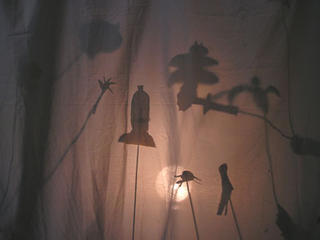Monday, December 19, 2005
Doing Kindermusik Down Under
The University of Tasmania in Australia is undertaking a longitudinal study assessing how music affects young children, with regard to identity development, self-esteem, socialization and school readiness, and has chosen Kindermusik to follow for three years.
Wednesday, November 16, 2005
Interesting, yes
There are lots of litle research bits about the connection between music and smart, successful, and happy people. Of them all, a Harvard study is my favorite. A few years back Lois Hetland found that yes, music does seem to have an influence on spatial reasoning, but we should play music for music's sake. Because it's part of being human, because it teaches your child things other subjects can't, play music.
Even still, I like the solid research, stuff, too:
Even still, I like the solid research, stuff, too:
- In academic situations, students in music programs are less likely to draw unfounded conclusions. Champions of Change, Federal study, 1999
- Students who can perform complex rhythms can also make faster and more corrections in many academic and physical situations. Center for Timing Coordination and Motor Skills, 2000
- College admissions officers continue to cite participation in music as an important factor in making admissions decisions. They claim that music participation demonstrates time management, creativity, expression, and open-mindedness. Carl Hartman, The Associated Press, October, 1999
Thursday, October 20, 2005
I knew it.

Now, I'm no mother myself, but I'm quite fond of them. It's something I aspire to someday. Still, if my own children ever come my way, I hope they can accept me just the way I am, imperfect and all. Breaking into their finger paints, taking over craft time, and nap time, and stealing fries from their happy meals. So the mother sharing her story on NPR.org -- she's a mother after my own heart.
Tuesday, October 04, 2005
A tribute

"Contrary to what most people think, it's not defeatist, 'Oh, woe is me,' " says Pulitzer Prize Winner August Wilson about his life's inspiration, the blues. "It's very life-affirming, uplifting music. Because you can sing that song, that's what enables you to survive."
Friday, September 23, 2005
A struggle for words in Kindermusik
Even as a writer for Kindermusik, it can be such a wonderful struggle to describe what happens in a Kindermusik class.
You'll ask a parent to explain it and you can see them go in for the word and come up with something like "we just love it." It's like asking someone to describe an emotion--be it sad, or happy. Go in for the words, and you realize you'll come up short.
This writer from the Baltimore Sun did a great job, using many words, to describe what happens in Kindermusik. It strikes the right tone of explaining that on some level we all know how to do Kindermusik with our child. It's innate.
Maybe that's why it's so difficult to describe.
You'll ask a parent to explain it and you can see them go in for the word and come up with something like "we just love it." It's like asking someone to describe an emotion--be it sad, or happy. Go in for the words, and you realize you'll come up short.
This writer from the Baltimore Sun did a great job, using many words, to describe what happens in Kindermusik. It strikes the right tone of explaining that on some level we all know how to do Kindermusik with our child. It's innate.
Maybe that's why it's so difficult to describe.
Monday, August 15, 2005
What it takes to be a great teacher
Strong knees. We bend down a lot because we need to see things from a child's point of view.
A healthy sense of humor. Sometimes we have to laugh at jokes that really aren't that funny. Rhythm. Speak directions in easily repeatable rhymes, and before long, a child can repeat them back to you, and eventually teach them to others.
Literally, a hard head. Some little ones are still learning the difference between a throw and toss, and sometimes that means getting bonked on the head. Laugh that one off, too.
The ability to listen. A child doesn't know how to be a good listener if someone doesn't listen to him.
The ability to provide running commentary. Especially with young children who are still learning to talk, the ability to improvise and narrate the story as they go about the house is a clever way to teach language and storytelling to children.
Curiosity. In art, phrases like "good job" make the product seem more important than the process. Ask questions instead, "I like the red you used there, why did you decide to do that?"
A healthy sense of humor. Sometimes we have to laugh at jokes that really aren't that funny. Rhythm. Speak directions in easily repeatable rhymes, and before long, a child can repeat them back to you, and eventually teach them to others.
Literally, a hard head. Some little ones are still learning the difference between a throw and toss, and sometimes that means getting bonked on the head. Laugh that one off, too.
The ability to listen. A child doesn't know how to be a good listener if someone doesn't listen to him.
The ability to provide running commentary. Especially with young children who are still learning to talk, the ability to improvise and narrate the story as they go about the house is a clever way to teach language and storytelling to children.
Curiosity. In art, phrases like "good job" make the product seem more important than the process. Ask questions instead, "I like the red you used there, why did you decide to do that?"
Thursday, July 21, 2005
Create a musical garden
One thing we're doing here at Kindermusik International is creating a musical garden. Using old instruments, such as upside-down drums for planters, hollowed-out guitars for flower beds, and trumpets and bassoons stuck in the ground like blooming plants--we're creating a visual epitome what we do every day at Kindermusik: find creative ways to integrate music into every aspect of life.
Why not start a musical garden of your own?
Why not start a musical garden of your own?
- Look for old instruments at garage sales, flea markets, and second-hand stores.
- Clean the instruments as best as you can.
- Apply four coats of polyurethane, letting each coat completely dry before applying the next.
- Stick the instruments into your garden as if you're garden is growing instruments!
For more inspiration, look at these hand-crafted, musical furniture pieces.
Tuesday, July 19, 2005
When do imaginary friends go too far?
 Even the greatest child development thinkers can be wrong a time or two. In the 1960s, Swiss Child psychologist Jean Piaget and Dr. Spock thought imaginary friends to be a bad thing. Even today some parents worry when an extra plate and empty chair appears at the dinner table.
Even the greatest child development thinkers can be wrong a time or two. In the 1960s, Swiss Child psychologist Jean Piaget and Dr. Spock thought imaginary friends to be a bad thing. Even today some parents worry when an extra plate and empty chair appears at the dinner table.But a new study in Developmental Psychology says not to worry. School-age children who had imaginary friends had a more developed “theory of the mind,” or the understanding that others have thoughts and feelings, too.
“Imaginary friends, often associated with introverted or disturbed children, are an integral part of social development, giving young ones an outlet for difficult feelings or confusion," according to the May 25 article in the San Jose Mercury News.
Still, if a Kindermusik parent in your class is concerned about a child’s new pretend play-pal, experts in the San Jose article say there are a few things a parent can watch for when it comes to healthy relationships with imaginary friends:
- Most imaginary friends stick around for a year.
- They often appear most notably between the stages of imaginative play and language development (the study notes that 6- and 7-year-olds were just as likely to have imaginary friends as 3- and 4-year-olds).
- Make sure that fantasy is not interfering with normal life.
- The imaginary friend should be under the child’s control—not encouraging bad behavior in the child.
Monday, July 18, 2005
Organize artwork
For more ideas on getting organized, go to www.getorganizednow.com
Organizing Kids Artworkby Maria Gracia
A picture is worth 1,000 words. Take photos of the artwork that your child creates and keep these photos in a scrapbook. This way, even if the artwork is discarded for space purposes, you'll still have the memory!
Keep it contained. For other artwork that does not lay flat, the perfect container may be a large, plastic container with a lid. Your child will have a space for shadowboxes, and other artwork that won't fit into a file folder.
Hang it. Get your child his very own artwork bulletin board so he can display his favorite artwork in his bedroom. When organized on a nice cork board, this really adds a nice touch to a child's room. Plus, your child can very easily switch one piece of art, with another.
Supply mania. If your child produces a lot of artwork at home, she probably has tons of crayons, markers and other art supplies. Keep it all in a portable box, light enough for your child to be able to transport it from one room into the next. In addition, separate and organize the supplies into separate Zip-lock baggies before putting them in the box. This will keep everything organized and easily accessible.
The perfect gift. Kids artwork makes the perfect gift for grandma, grandpa, sister Jane, Aunt Sue, Uncle Jim, and so on. Rather than buying gifts for your child to give to family members, encourage them to give their creations away as special gifts to special people.by Maria Gracia - Get Organized Now!Want to get organized? Get your FREE Get Organized Now! Idea-Pak, filled with tips and ideas to help you organize your home, your office and your life, at the Get Organized Now! Web sitehttp://www.getorganizednow.com
Organizing Kids Artworkby Maria Gracia
A picture is worth 1,000 words. Take photos of the artwork that your child creates and keep these photos in a scrapbook. This way, even if the artwork is discarded for space purposes, you'll still have the memory!
Keep it contained. For other artwork that does not lay flat, the perfect container may be a large, plastic container with a lid. Your child will have a space for shadowboxes, and other artwork that won't fit into a file folder.
Hang it. Get your child his very own artwork bulletin board so he can display his favorite artwork in his bedroom. When organized on a nice cork board, this really adds a nice touch to a child's room. Plus, your child can very easily switch one piece of art, with another.
Supply mania. If your child produces a lot of artwork at home, she probably has tons of crayons, markers and other art supplies. Keep it all in a portable box, light enough for your child to be able to transport it from one room into the next. In addition, separate and organize the supplies into separate Zip-lock baggies before putting them in the box. This will keep everything organized and easily accessible.
The perfect gift. Kids artwork makes the perfect gift for grandma, grandpa, sister Jane, Aunt Sue, Uncle Jim, and so on. Rather than buying gifts for your child to give to family members, encourage them to give their creations away as special gifts to special people.by Maria Gracia - Get Organized Now!Want to get organized? Get your FREE Get Organized Now! Idea-Pak, filled with tips and ideas to help you organize your home, your office and your life, at the Get Organized Now! Web sitehttp://www.getorganizednow.com
Tuesday, July 12, 2005
Who needs an iPod when you have a brain?

Scientists are now discovering "musical hallucinations." Something I suspect the mind does to comfort itself. Something that scientists suspect will continue happening as people are continually bombarded by sounds: clever cell phone rings, commercial jingles, email "dings."
Want to know how the mind takes all that sound in?
"Our brains use special networks of neurons to perceive music," according a story in the Science section of the New York Times. "When sounds first enter the brain, they activate a region near the ears called the primary auditory cortex that starts processing sounds at their most basic level. The auditory cortex then passes on signals of its own to other regions, which can recognize more complex features of music, like rhythm, key changes and melody."
The article goes on to talk about one of the most extensive studies of people who experience musical hallucinations.
Monday, July 11, 2005
Turn on the shadow pupppets
 Take the TV out of a child's bedroom. Put in a shadow puppet theater. Or play music. Read a story. Act the story out.
Take the TV out of a child's bedroom. Put in a shadow puppet theater. Or play music. Read a story. Act the story out.A new study in the New York Times throws even more light on why there is a dark side to putting a television in a child's bedroom. It's not that TV itself is bad. It's when and where a child watches TV, according to the New York Times article, that's causing static in a child's ability to learn math.
Share this study with families in class today and talk about the options: "What can you and your child do to replace television in the bedroom?"
- Play classical music and wave flashlights to the music
- Plug in a night-light
- Tape pictures from your favorite books on the wall and make up stories about the characters
- Throw Kindermusik colored scarves over the lamps to change the light in the room
- Grab a flashlight, a white sheet, and make shadow puppets from cardboard
Thursday, June 30, 2005
Sign & Sing
"Eases frustration." "Soothes trantrums." That's what the studies about sign language for children say, yes. Great. I find myself a little more startled, really, you could say dumb-founded, when I see a child use sign language. Suddenly I'm thinking they're smarter than me. When they tap their hands together and ask for more juice, I'm like, well, golly. Okay. More juice it is. You can't even hold a sippee cup yet without dropping it, but you can tell me what you need, and for that, I'm amazed and I'll submit. I'll say that's easing some frustration, yes.
Teaching sign language in your Kindermusik studio can ease some frustration for you, too. Read how, here.
Teaching sign language in your Kindermusik studio can ease some frustration for you, too. Read how, here.
Tuesday, June 28, 2005
This is me

Hi. Just starting this blog as a bit of an experiment, as a way to see how Kindermusik Educators can use blogs as a newsletter to stay in touch with families, keep up on the latest child development research, and the latest goings-on. We're a very entertaining, interesting crowd, you know.
Pictured here is me, Molly McGinn, when I was 5 years old. Today I'm a senior writer here at KI, and this is my blog.
So what does "i am kindermusik." mean? The idea came when I was riding my skateboard down the street, singing with the radio, watching traffic, listening to traffic (Greensboro drivers don't have a lot of experience with pedestrians) and pumping my foot in rhythm to the music: When I'm using more than one skill ... when I think, reason, create, move and express all at once ... I'm having a Kindermusik moment.
As a Kindermusik Educator I help children use more than one learning skill at once. As a writer what I do for Educators is to help you use more than one skill at once--in teaching, running your business, and riding a skateboard, if that's what you want to do.
Things children are not doing when watching TV
FYI, this isn't a PSA on unplugging the tv. I would never deny any child the squealing delight that comes from watching Nemo. I've never seen anything so compelling be so dulling at the same time. And to a child's brain, which is developing at a high speed, watching television is like being stuck in a traffic jam. It only moves forward at a very slow pace. Only two learning senses are work. Want to know what else isn't working?
Things Children are NOT Doing When Watching TV
1. looking left to right, strengthening reading skills
2. practicing motor skills, such as running, jumping, or using scissors
3. practicing eye-hand coordination
4. using more than 2 senses
5. asking questions
6. exploring
7. exercising innovation & motivation
8. being challenged
9. solving problems
10. thinking analytically
11. exercising imagination
12. practicing communication skills
13. being either creative or constructive
Thanks to Kindermusik Educator and Do-Re-Me & You! Consultant Jeanne Lippincott in Oxford Mississipi for providing this list.
Things Children are NOT Doing When Watching TV
1. looking left to right, strengthening reading skills
2. practicing motor skills, such as running, jumping, or using scissors
3. practicing eye-hand coordination
4. using more than 2 senses
5. asking questions
6. exploring
7. exercising innovation & motivation
8. being challenged
9. solving problems
10. thinking analytically
11. exercising imagination
12. practicing communication skills
13. being either creative or constructive
Thanks to Kindermusik Educator and Do-Re-Me & You! Consultant Jeanne Lippincott in Oxford Mississipi for providing this list.
Monday, June 27, 2005
Mechanical marvels

This article on the mechanical musical marvels on display at the Morris Museum is worth a look and listen. Sound clips and mini-movies show close-ups of these "mechanical banjo-hand pickers" inside a grandfather clock case, porcelain dolls playing and singing music, and mechanical mime-looking frenchman playing magic tricks.
Here's what the Web site says about this ring that pictures a music lesson: "The scene depicts a music session in an elegant drawing room, replete with a hanging oil lamp, a bird sitting on a three-legged music stand, and a pet dog. When set into motion, the seated woman hand-cranks a 'serinette'—an organ used to train birds to sing melodies—and the man conducts the tempo with his violin bow."
This made me think of all the great, home-made instruments we make in Kindermusik classes. Why not create your own "museum of great instruments" in your Imagine That! class and ask the kids to talk each.
Parents really do teach rhythm
New study in Canada proves that a parent passes on rhythm to her child when they dance together.
Wednesday, April 27, 2005
The importance of using scissors
One of the most surprising benefits from an early education in music is the ability to use .... drum roll please ... scissors. Seriously. There's a rhythm to using scissors, a coordination of the fine motor skills, the thumb and pointing finger, working together, yet separately. Eye-hand coordination is moving the hand and scissors forward in a straight line without cutting off anything really important. (Gulp). Like a finger.
Practice with rhythm and instruments helps a child use scissors. Not so funny thing is that kindergarten teachers say that children are starting school without this very basic skill.
Read it here in the Chicago Tribune.
Practice with rhythm and instruments helps a child use scissors. Not so funny thing is that kindergarten teachers say that children are starting school without this very basic skill.
Read it here in the Chicago Tribune.
Subscribe to:
Posts (Atom)